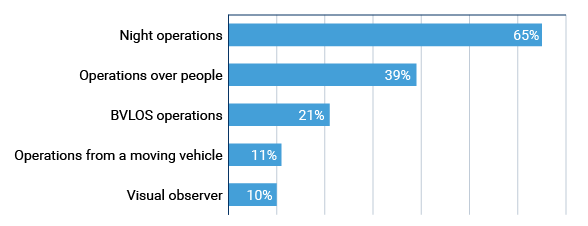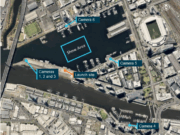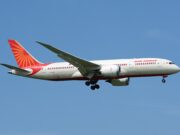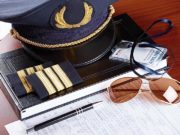
Blue-green, wallet-size cards now carried by U.S. remote pilots of small unmanned aircraft systems (sUAS) closely resemble the certificates that airline transport pilots and other safety-certificated airmen have earned. Technically, the distinguishing elements are the background artwork and the acronym UAS in prominent white text. Culturally, the similarities are not coincidental; they reinforce the safety-critical responsibility and authority that holders must exercise to fly these drones (ASW, 5/15).
This pilot rating — introduced Aug. 29, 2016 — and its effect on the sUAS domain came up frequently in panel discussions held by Federal Aviation Administration (FAA) officials and UAS industry safety leaders at the FAA UAS Symposium on March 27–29 in Reston, Virginia. Between August 2016 and late March, FAA issued more than 37,000 remote pilot certificates. A key interest of the panelists and attendees was how well the remote pilots will accept and proactively manage the risks of their flight operations in the National Airspace System (NAS) under U.S. Federal Aviation Regulations (FARs) Part 107, Small Unmanned Aircraft Systems.

Airline pilot panelists emphasized that the mindset during flights by remote pilots, regardless of today’s relative simplicity of Part 107 qualifications, should be comparable to what is expected of manned aircraft pilots. Bryan Quigley, managing director and system chief pilot, United Airlines, and co-chair, FAA Drone Advisory Committee Subcommittee, said, “We assume that when aviators climb in the cockpit and carry passengers around the world that they’re going to understand what the rules are. They’re going to be willing and they’re going to be able to comply with them. That’s the same thing that I would expect from anybody that’s flying a drone. There are certain conditions that you can cause while operating that drone that can be incredibly risky.
“If airplane pilots see drones on approach to the airport, the question to ask is ‘How did those drones get there?’ I actually believe that the vast majority got there because somebody lost control of that aircraft or they just had no idea where they were operating. A rather small number [of sUAS-pilot respondents] reported back on our subcommittee’s last survey that they had lost control. I’m making this up, but let’s just say it’s 10 percent — if 10 percent of 2 million [sUAS] aircraft have lost control, that’s a lot of opportunity to be sighted operating in the wrong place.”
FAA Administrator Michael Huerta described the back story of Part 107’s lengthy cultural clash this way: “Now we’re ushering in a new age of aviation here in America — the unmanned aircraft era. And it’s moving at a quicker pace than anything that any of us have seen before. It’s fair to say that what is sometimes called the ‘traditional aviation industry’ has its own culture and that [the] unmanned aircraft [community] has a culture that is quite different from that. The traditional aviation culture is a very cautious culture. Nobody wants to be the one who messes up what has been an incredible safety record. The UAS community comes to us with a culture that is predicated much more on innovation, on getting products to market as quickly as possible. And they want the market to serve the sorting function — of ‘making the product better.’ It is important that the cultures coexist and work together.” Huerta and other FAA panelists noted that the agency has developed what one called an “enormous willingness to trust” remote pilots flying sUAS aircraft in the NAS under Part 107.
Earl Lawrence, director, FAA UAS Integration Office, said he has to be constantly aware of the week-to-week pace of sUAS innovation, anticipating millions of drone operators and managing the already-high volume of these aircraft. “In the FAA, we’re just not used to dealing with the numbers that we’re dealing with. It just changes even the basic systems that we have,” he said. “Drones in your backyard is kind of a new experience to us all … the realization that we’re not just integrating drones into the FAA or into the NAS, but we are integrating into society a whole new technology. To do this, we really need to focus on some keystones: safety, shared accountability and collaboration.”
From the drone industry’s perspective, Ben Marcus, CEO, AirMap, and co-chair, Unmanned Aircraft Safety Team (UAST), said that despite awareness of safety data gaps, early research has given this team’s analysts the anecdotal impression of positive progress toward the desired sUAS safety level and appreciation of the need to calculate rates of sUAS safety events. “This data bracket is a real challenge to the UAST because we don’t have any ‘real accidents’ to analyze. Thankfully today, sUAS are pretty safe. You just don’t hear about fatalities. So I think we’re starting in a good place.”
AirMap, which offers an airspace-management services platform for drone flights, already services more than 100,000 drone flights per day, he said. “The UAST wants to enable [studying] more kinds of use cases over time. On the [occurrence-rate] denominator side, we’re looking for data similar to what the airlines have been collecting for flight operations quality assurance. So how do we collect a broad corpus of operational data? We have a group within the UAST working with large operators and manufacturers that have already volunteered to share a lot of this data.” Details of data confidentiality and protection are still being developed.
| Aircraft Requirements* | Pilot Requirements | Airspace Requirements | Types of Operation | |
|---|---|---|---|---|
| COA = certificate of waiver or authorization; FARs = U.S. Federal Aviation Regulations; UAS = unmanned aircraft system; VLOS = visual line of sight
* All UAS greater than 0.55 lb must be registered (see Part 47 and Part 48 requirements) Source: U.S. Federal Aviation Administration UAS Symposium |
||||
| FARs Part 107 | UAS < 55 lb (25 kg) | Part 107 remote pilot certificate with small UAS rating | Airspace waiver or authorization for Class B, C, D, E airspace | VLOS, daytime, Class G, 400 ft, not over people; or waiver provisions |
| Section 333 | As specified in exemption | Part 61 airman certificate | Blanket COA or Standard COA for specific airspace | UAS > 55 lb |
| Experimental aircraft | Experimental Special Airworthiness Certificate | Part 61 airman certificate | Standard COA for specific airspace | Research and development, crew training and market survey |
| Type certificated aircraft | Restricted type or special class certification | Part 61 airman certificate | Part 91 airspace requirements | Specified in operating authorization |
| Public aircraft | Self-certification by public agency | Self-certification by public agency | Blanket COA or Standard COA for specific airspace | Public Aircraft Operations (AC 00-1.1A) UAS Test Site operations |
| Part 101 model aircraft | UAS < 55 lbs. | Community-based organization (CBO) standards | Notification requirement within 5 mi (8 km) of an airport | Hobby or recreational, VLOS, Part 101 operating rules, CBO standards |
Remote Pilot Indoctrination
FAA panelists summarized the knowledge, skills and attitudes that remote pilots are expected to possess while exercising their flight privileges, as explained in today’s “ground school” training curriculum and multimedia resources designed for written test preparation and periodic refreshers. Among points underscored were the “homework” of carefully assessing operating conditions before and during every flight; explicitly designating the remote pilot-in-command (PIC) for each flight; studying scenarios in which the PIC may need to exercise authority to deviate from regulations in the immediate interest of safety and later be able to justify the decision, if required; understanding how FAA enforces compliance with restrictions such as flying near people but not flying directly over people, safe coverage structures for people under the flight path of a drone and maintaining direct visual line of sight with the aircraft; yielding right of way to all other aircraft; avoiding interference with the traffic patterns at any airport; obeying strict prohibitions against dropping objects from a drone; and realizing the broad scope of behavior, inaction and failures that FAA could identify as “careless and reckless operations.”
Joe Morra, manager, FAA Safety and Operations Branch, FAA UAS Integration Office, said that upon receiving the remote pilot certificate, safety becomes the airman’s personal responsibility. “You’re part of the safety culture, and you are flying with airline pilots. It’s Class G [uncontrolled] airspace at 400 ft AGL [above ground level] unless you’re within 400 ft [122 m] of a structure. You keep the drone 2,000 ft [610 m horizontally] from a cloud. Airliners pop out of clouds all the time. You need enough distance to make sure that you’re not going to impact, or even come close, to that aircraft. You need to understand, beyond the regulations, how to utilize those regulations safely.” (Among other Part 107 operating restrictions relevant to collision avoidance, the sUAS aircraft also must be no less than 500 ft below the cloud, minimum flight visibility as observed from the control station must be no less than 3.0 mi [2.6 nm/5 km] and the groundspeed of the sUAS aircraft may not exceed 87 kt [100 mph/161 kph].)
Steve Jangelis, aviation safety chairman, Air Line Pilots Association, International (ALPA), and a Delta Air Lines captain, told the symposium that the union supported FAA’s slow and methodical approach during Part 107 rulemaking — most of all, ensuring that people flying aircraft under this regulation are regarded by society as aircraft pilots. “Congratulations! We are all sharing this airspace as a result, and we’re happy to share,” he said. “We wanted to make sure that we have folks flying who are called pilots not operators. The bottom line is that a well-educated, well-trained pilot is the best safety tool.
“But whether you’ve done 10 or 20 years as an aviator in the military or four years at an advanced school to get your flight experience, training takes you to the minimum, and so do these regulations. The remote pilot certificate is a license to learn.
“Our big concern — as we look at a drone made of plastics, steel, composites and lithium batteries — is what happens when it goes into an airplane engine. I know I’m ‘selling’ a little bit of fear here, but it could happen. Ten years ago, airline pilots were saying, ‘Dual-engine failure due to birds will never happen.’ So we fear that the next collision will be with a large drone or a small drone in our airspace or another object that isn’t manned. When we start getting into flying larger UAS aircraft operating beyond visual line of sight, that’s another big concern to us.”
ALPA also considers practical demonstrations of proficiency in piloting each type of sUAS aircraft to be flown a very important issue. He added, “I know it’s not technically an FAA requirement right now, but I think it’s something remote pilots need to [consider]. Introducing sUAS aircraft into controlled airspace adds risk to airline passengers, cargo operations and the public at large. In order to maintain safety, remote pilots will be required to reliably and consistently control the sUAS aircraft with a higher degree of accuracy and pilot proficiency [than in Class G airspace]. Learn what your vehicle can do. Stay in touch with the manufacturer on any software updates, geofences and things like that. It’s also your responsibility as pilot-in-command to make sure that you’re aware of everything on board that aircraft, and operate it in a safe and methodical manner.”
Waivers Unlock Extra Privileges
Remote pilots benefit from substantial freedom and autonomy to fly their registered aircraft just by complying with the provisions of U.S. Federal Aviation Regulations (FARs) Part 107, Small Unmanned Aircraft Systems(sUAS). For remote pilots or operators that pursue a waiver — authorization to deviate from the regulation — the application-review process can be intentionally arduous, say some officials of the Federal Aviation Administration (FAA).
Waivers could be characterized as enabling expanded privileges that the FAA may grant temporarily on a case-by-case basis through this nominally 90-day process. Technically, FARs Section 107.200(a), “Waiver policy and requirements,” states that the FAA administrator may issue a certificate of waiver authorizing a deviation from any regulation specified in Section 107.205, “List of regulations subject to waiver,” if the administrator finds that a proposed sUAS operation can safely be conducted under the terms of that certificate of waiver. Currently, FAA typically grants waivers for 24 calendar months but possibly for up to 48 calendar months in cases of long-term or recurring flight operations.
Intriguing possibilities have been imagined for waivers to accommodate new UAS technologies and/or cases of unique operational circumstances. The opportunity to fly drones free of one or more of the nine prohibitions in 107.205 stimulated numerous panel discussions and audience questions at the FAA UAS Symposium, held March 27–29 in Reston, Virginia. (The accompanying main article describes how FAA headquarters separately handles air traffic control sUAS airspace waivers and airspace authorizations. The latter is a three- to five-week application-review process to analyze remote pilots’ or operators’ applications for approval to transit or operate up to 400 ft above ground level within controlled airspace, at specific times, over a period lasting up to six months.)
FAA panelists said that the “non-airspace-associated” Part 107 waivers incentivize and challenge remote pilots and operators to go deeper in identifying real-world risks and in proposing credible mitigations. James Viola, manager, General Aviation and Commercial Division, FAA Flight Standards Service, also said that while FAA already has “lifted restrictions on all kinds of different things” in this context, the agency avoids trying to constrain, define or dictate a specific solution to the individual remote pilot/operator.
Brad Zeigler, aviation safety analyst, Airman Training and Certification Branch, FAA Flight Standards Service, said, “The most common waiver request is for night operations, followed by requests for operations over people, operations beyond visual line of sight and operations from a moving vehicle. We have issued almost 400 non–airspace-associated waivers. About 312 of them are posted on our website.” These include the certificates of waiver issued and the FAA conditions associated with each waiver, offering valuable insights to others on what FAA has approved, he said.
“You’re going to have a pretty hefty load to carry in terms of convincing us that you can do all of the things that you’re describing,” Zeigler told attendees. “So only ask for what you need. Then only send us the information that we need to consider your application. We don’t have time to go through 2,000 pages just so we can issue an ‘authorization of operations at night’ waiver.”
Examples he gave of denied waivers typically revealed applicants’ misunderstanding of the application process, despite FAA’s enhanced website instructions and free personalized advice. FAA also strongly discourages anyone from copying the work of others or taking similar shortcuts from original analysis, an easily recognized characteristic of some denied applications.
Examples also reflected that many remote pilots are new aviators who have never requested a waiver from FAA. Their applications especially show little or no understanding of the obligation to identify risk probability and severity, or how to clearly explain their risks and persuasively argue how their proposed mitigations conform to FAA performance-based standards and would be effective. The most difficult waivers to grant have been flying over people and flying beyond the visual line of sight, Zeigler said.
— WR
Revolutionary Change
By several FAA panelists’ estimates, finalizing Part 107 “changed everything” by essentially preauthorizing remote pilots to fly sUAS aircraft at up to 400 ft AGL in the Class G airspace now depicted by FAA on digital sectional aeronautical charts. They noted that Class G constitutes about 90 percent of all low-level airspace in the NAS.
Under Part 107, remote pilots or operators have flexibility to conduct non-commercial or commercial or public aircraft flights of small UAS (weighing 0.55 lb [0.2 5kg] to less than 55 lb [25 kg]).
The public demand already experienced by FAA shows that a large subset of all remote pilots wants to fly their aircraft through controlled airspace as soon as possible, and panelists said the key to facilitating that capability is the remote pilots of sUAS being aware of manned aircraft that could be flying in the same airspace.
In this context, James Eck, assistant administrator, FAA NextGen Office, said the agency encourages remote pilots — but does not require them — to apply the best training, procedures and technologies at their disposal (such as monitoring ground control station–sited receivers of automatic dependent surveillance–broadcast [ADS-B Out] messages from manned aircraft) to detect manned aircraft or even large drones, and to take immediate action to see other aircraft and avoid a collision. “ADS-B will play more of a safety role for unmanned aircraft to stay clear of manned aircraft that are radiating ADS-B,” he said.
Symposium panelists also noted that remote pilots, with few exceptions, ideally should “guard” relevant aeronautical radio frequencies but not initiate voice communication with air traffic control (ATC), airport authorities or pilots of other aircraft because such calls could saturate ATC communications.
Remote pilot certification is based on scoring 70 percent correct answers on a proctored multiple-choice written examination representing key knowledge areas, and on a background check by the Department of Homeland Security. The knowledge areas comprise: applicable regulations relating to sUAS rating privileges, limitations and flight operation; airspace classification and operating requirements, and flight restrictions affecting sUAS aircraft operation; aviation weather sources and effects of weather on sUAS aircraft performance; sUAS aircraft loading and performance; emergency procedures; crew resource management; radio communication procedures; determining the performance of sUAS aircraft; physiological effects of drugs and alcohol; aeronautical decision making and judgment; airport operations; and sUAS aircraft maintenance and preflight inspection procedures.
By comparison with the 37,000 remote pilot certificates issued, about 600,000 FAA manned aircraft pilot certificates are now in circulation, and since late 2016 — when registration of all UAS aircraft and model aircraft became mandatory — FAA has registered about 770,000 drones. However, most of these drones are model aircraft flown by hobby or recreational drone owners under community-based organization standards defined by the Special Rule for Model Aircraft (Public Law 112-95, Section 336) and FARs Part 101, Subpart E, Model Aircraft; a U.S. federal appeals court in mid-May struck down the registration requirement as it applied to hobbyists.
Trusting Remote Pilots
An individual’s FAR-compliance intent — demonstrated by pilot certification and drone registration — normally leads FAA to presume that a given remote pilot intended to comply with all applicable FARs. Peggy Gilligan, who retired March 31 as associate administrator of the FAA Aviation Safety Organization, said that in regulatory enforcement, the agency therefore first turns to its compliance philosophy–based policy.
“If you’ve gone to the trouble of understanding what waivers and other approvals you might need, that shows you mean to do this correctly,” she said. “By and large, folks who operate in the NAS are voluntary compliers. UAS is a new community; so you do need to demonstrate that your intention is to be in compliance. Then if there is some time that you are not compliant, our approach will be to understand why that happened, and we and you will make sure it doesn’t happen again.”
Brad Zeigler, aviation safety analyst, Airman Training and Certification Branch, FAA Flight Standards Service, said that the consequences of any remote pilot’s reckless, careless or willfully noncompliant behavior while flying an sUAS aircraft could disrupt or ruin an aviation career if that person also happens to be a pilot, aviation maintenance technician, air traffic controller, aviation safety inspector or flight attendant, for example. “If you do something that is so egregious or is a fraudulent case, then it is possible that it could affect your other certificates. For the more malicious or egregious or intentional cases, all certificates are potentially affected,” he said.
Written applications for these waivers are granted or denied on a case-by-case basis and approval is contingent on the remote pilot (or operator) writing an adequately detailed, well-reasoned risk analysis and suitable risk mitigations that FAA finds acceptable. The waiverable provisions (and location in the regulation) are known as: operation from a moving vehicle or aircraft (107.25); daylight operation required (107.29); visual line of sight aircraft operation required (107.31); visual observer required (107.33); operation of multiple sUAS aircraft by one remote pilot prohibited (107.35); yielding the right of way to all other aircraft (107.37 [a]); operation over people prohibited (107.39); operation in certain airspace prohibited (107.41); and operating limitations for sUAS (107.51). See details at <faa.gov/uas/request_waiver/>.
Brian Wynne, president and CEO of the Association for Unmanned Vehicle Systems International, said his organization’s analysis of 320 Part 107 waivers showed that 94 percent involved proposed exceptions to the standard prohibition against night flying of sUAS aircraft.
Waivers to Part 107

BVLOS = beyond visual line of sight.
Source: U.S. Federal Aviation Administration UAS Symposium
FAA expects Part 107 waivers to be expedited during 2017 when the remainder of 900 Low Altitude Authorization and Notification Capability (LAANC) facility maps for Classes B-C-D-E airspace are released within FAA and to the public (see “Safety News,” ASW, 4/17). These free digital maps show controllers, and will show remote pilots, the pre-approved airspace near airports where ATC most readily and safely could authorize remote pilots to fly.
Headquarters staff in the FAA Air Traffic Organization already use a centralized system to process applications from remote pilots who seek temporary ATC authorizations to fly within one or more predefined blocks of controlled airspace. These authorizations normally function without subsequent real-time voice or data communication between remote pilots and ATC, or any sUAS avionics to make these drones detectable to air traffic controllers or to pilots of manned aircraft or drones in the vicinity. Comparable work in progress includes the FAA’s program to replace cumbersome and disconnected processes for ATC authorizations using fully automated services to registered remote pilots and others through public portal–database technology, agency officials said.
Introducing the certificated remote pilot as a safety factor completes the second phase of long-term FAA UAS initiatives. The FAA’s risk-based introduction of all kinds of UAS into the NAS comprises the following sequential steps: assuring that hobbyist/recreational operations of drones and traditional model aircraft continue within safe confines (done); introducing safe and routine low-altitude flights by certificated remote pilots who are responsible for small UAS aircraft in uncontrolled airspace within their visual line of sight (done); expanding Part 107 to routinely allow sUAS operations over people (a near-term objective); expanding Part 107 to allow beyond visual line of sight operations (a near-term objective); introducing integrated/ATC-controlled UAS operations throughout the NAS (a long-term objective); and future aircraft automation enabling UAS-like pilotless operation of large aircraft, with and without passengers (an aspiration receiving early consideration).
In summary, symposium panelists stressed, the newly minted remote pilots have a historic opportunity to positively influence a scenario in which sUAS aircraft fly with predictability and reliably avoid collision with manned aircraft through compliance with Part 107, waivers and ATC authorizations. Many remote pilots and sUAS operators also could equip themselves for optimum situational awareness of manned aircraft while regularly updating their knowledge, skills and attitudes that affect the level of safety.
Concise Application Leads to FAA Waiver
The FAA UAS Symposium included a story about successfully obtaining a certificate of waiver from the U.S. Federal Aviation Administration (FAA). The waiver pertained to remote pilots flying small unmanned aircraft system (sUAS) aircraft in commercial operations outside the visual line of sight of the remote pilot-in-command and, in specified situations, without a visual observer.
Diana Cooper, vice president of legal and policy affairs, PrecisionHawk, summarized how the company met FAA safety expectations. The proposed sUAS flights would collect data, develop operational standards and create technologies necessary to ensure an adequate level of safety in beyond visual line of sight (BVLOS) agricultural operations and in a subset of BVLOS called enhanced visual line of sight (EVLOS) operations in other settings. These activities were part of a 2015 cooperative research and development agreement associated with FAA’s Pathfinder program research on sUAS.
The decision — granting the waiver on Aug. 29, 2016, and making it effective until Aug. 31, 2020 — waived U.S. Federal Aviation Regulations (FARs) Part 107.31 “Visual line of sight aircraft operation” and FARs 107.33, paragraphs (b) and (c)(2) “Visual observer,” essentially enabling a remote pilot for PrecisionHawk to fly an aircraft up to 2.5 nm [2.9 mi/4.6 km] while flying without a visual observer, and to extend that operating area while flying with a visual observer.
“Phase I of our research was focused on identifying the range at which an intruding aircraft could be visually detected by the sUAS pilot. In Phase II, we looked at both detection and then the pilot’s reaction,” Cooper said. “The definition we used is that EVLOS is conditions where you can’t actually see your drone because it’s too far away, but you can see and scan the airspace and you would be able to detect an intruding manned aircraft.” The Pathfinder work enabled the company to cite its own safety-case data in the waiver application using a 23-page concept of operations and a 20-page operational risk assessment. She encouraged the audience to borrow the company’s concepts.
“We determined that the safe distance where you can detect an intruding manned aircraft is roughly 2.5 nm provided that certain conditions are met — weather, visibility, requirements for the pilot training, and things like that. We also described the process by which an intruding manned aircraft would be detected and avoided under our operations,” she said. “The pilot would initially detect the intruding aircraft using the ground control station display, and, using the display, they would determine the relative position of the sUAS aircraft to the intruding manned aircraft. They would analyze the proximity and then, if needed, they would execute a maneuver to avoid any sort of collision.”
The waiver application summarized procedures for flight planning and preparation, site vetting, takeoff–launch and landing–recovery in PrecisionHawk’s flight operations manual and the associated personnel selection and training policies and methods.
“We looked at pilot qualifications — the training and experience that we would incorporate into our flight operations and require of our pilots who would be conducting EVLOS and BVLOS flights,” Cooper said. “We first train our pilots on visual line of sight operations so that they get used to conducting these operations in the setting where they later would be conducting the BVLOS operations. This gives them the opportunity to get used to drone operations and to the types of distractions that might be occurring in the particular environment … to learn to tune out farm equipment on the property or even possibly animals, for example. Once pilots have a sufficient level of knowledge and experience on visual line of sight operations, then we would move to training for EVLOS operations.”
In EVLOS, the remote pilot must scan normally blank airspace on the display for extended periods, looking for intruding manned aircraft. This activity entails human factors risks such as inattention, fatigue and distraction, which are well documented in the scientific literature of UAS and manned aviation. “So it’s easy to get bored, to get distracted by other things — especially if you’re conducting these operations many times, over and over again, throughout a single day,” she said.
“We limited our operation to fairly sparsely populated areas to mitigate the risks. Our waiver application also called out the meteorological conditions in Part 107 [Small Unmanned Aircraft Systems] — 3.0 mi [4.8 km] and clear of clouds. We also limited operations to daytime and Class G airspace — again, to limit the risks. We determined that safe operations would not really be dependent on the UAS platform itself but more on the flight control and the navigation systems that are on board the UAS. They ensure that drones will react in a particular way.”
The accompanying operational risk assessment detailed the company’s choices of methods to identify hazards associated with the proposed operations, personnel, environment and systems. “We applied both a quantitative analysis and a qualitative analysis to the hazards, mitigations and residual risk. We placed each hazard in a risk matrix based on the FAA Air Traffic Organization’s safety management system manual from the FAA website,” Cooper said.
One example she cited was the risk that a remote pilot fails to observe the intruding manned aircraft on the display because of a distraction. “The likelihood of this risk, we thought, was extremely improbable. Using the risk assessment matrix, the potential effect could be a midair collision and severity would be catastrophic,” she said.
The operational risk assessment concluded with the assertion that the company would apply its described mitigations — such as requirements for a semi-autonomous aircraft, ground station alerting of the remote pilot to any degraded system, and the remote pilot conducting every launch and recovery within visual line of sight — “to reduce residual risk so that there are no high-risk hazards associated with the proposed operation.”
— WR
Featured image: © pict rider | Adobe Stock
Sample UAS license: U.S. Federal Aviation Administration


